Paths to Policy Sustainability for Protecting Cultural Heritage: A Quantitative Analysis of Conservation Policies for the Great Wall Within the “Instrument–Objective–Stakeholder” Framework
Abstract
1. Introduction
2. Literature Review
2.1. Research on Cultural Heritage Protection Policies
2.2. Research Related to the Protection of the Great Wall Culture
2.3. Research Related to the Preservation of the “Great Wall-Type” Architectural Heritage in the Global Context
3. Analysis Framework and Data Collection
3.1. Three-Dimensional Analysis Framework Construction
3.1.1. X Dimension: Policy Instruments
3.1.2. Y Dimension: Policy Objectives
3.1.3. Z Dimension: Stakeholders
3.2. Policy Data Selection and Coding
3.2.1. Policy Text Selection and Preprocessing
3.2.2. Policy Text Coding
4. Policy Text Quantitative Analysis
4.1. Single-Dimension Analysis
4.1.1. X Dimension: Policy Instrument Analysis
4.1.2. Y Dimension: Policy Objective Analysis
4.1.3. Z Dimension: Stakeholder Analysis
4.2. Cross-Dimensional Analysis
4.2.1. “X–Y” Two-Dimensional Cross-Analysis
4.2.2. “X–Z” Two-Dimensional Cross-Analysis
4.2.3. “Y–Z” Two-Dimensional Cross-Analysis
5. Conclusions and Recommendations
5.1. Research Conclusions
5.2. Suggestions
5.2.1. Optimize the Mix of Policy Instruments to Drive Sustainable Development
5.2.2. Coordinate Policy Objectives and Deepen the Living Heritage Approaches
5.2.3. Balance Stakeholder Representation and Optimize a Diverse Participation Framework
5.3. Research Limitations and Future Research Directions
Author Contributions
Funding
Institutional Review Board Statement
Informed Consent Statement
Data Availability Statement
Acknowledgments
Conflicts of Interest
Abbreviations
| GWCP | Great Wall Cultural Preservation |
| SDGs | Sustainable Development Goals |
| WHC | World Heritage Convention |
| UNESCO | United Nations Educational, Scientific and Cultural Organization |
| NCHA | National Cultural Heritage Administration |
| MCT | Ministry of Culture and Tourism |
References
- UNESCO World Heritage Centre. Managing Cultural World Heritage. Available online: https://whc.unesco.org/en/managing-cultural-world-heritage/ (accessed on 19 March 2025).
- World Heritage Committee. World Heritage and Sustainable Development, World Heritage Committee, 39th Session, WHC-15/39.COM/5D; United Nations Educational, Scientific, and Cultural Organization: Geneva, Switzerland, 2015; Available online: https://whc.unesco.org/en/documents/137710 (accessed on 15 March 2025).
- World Heritage Committee. Policy Document for the Integration of a Sustainable Development Perspective to the Processes of the World Heritage Convention; United Nations Educational, Scientific, and Cultural Organization: Geneva, Switzerland, 2015; Available online: https://whc.unesco.org/en/documents/138856 (accessed on 15 March 2025).
- Liu, M.X.; Han, G.Y. A study on the current situation and problems of the Great Wall protection policy in China. J. Hebei Univ. Geol. 2017, 40, 137–140. [Google Scholar]
- State Administration of Cultural Heritage. Regulations on the Protection of the Great Wall [Order of the State Council of the People’s Republic of China (No. 476)]. Available online: http://www.ncha.gov.cn/art/2006/10/25/art_2237_33544.html (accessed on 19 March 2025).
- Wang, C.; Cui, H.Q. Quantitative evaluation of rural leisure tourism policies and development outlook. J. Tour. 2024, 39, 45–60. [Google Scholar]
- Liljeblad, J.; Oo, K.T.T. World Heritage Sustainable Development Policy & Local Implementation: Site Management Issues Using a Case Study of Sri Ksetra at Pyu Ancient Cities in Myanmar. Sustain. Dev. 2020, 28, 468–477. [Google Scholar]
- Li, M.; Zhang, L.; Huang, J.; Lu, Y. A Quantitative Evaluation Study on Return-to-Hometown Entrepreneurship Policies in 16 Provinces (Municipalities) and Autonomous Regions in China under the Rural Revitalization Strategy. Sustainability 2024, 16, 10283. [Google Scholar] [CrossRef]
- Veldpaus, L. Reconnecting the City: The Historic Urban Landscape Approach and the Future of Urban Heritage. Cult. Trends 2015, 24, 340–342. [Google Scholar] [CrossRef]
- Pickard, R. Setting the Scene: The Protection and Management of Cultural World Heritage Properties in a National Context. Hist. Environ.-Policy Pract. 2016, 7, 133–150. [Google Scholar] [CrossRef]
- Zhang, R.B. Historical and Cultural Heritage Preservation in the United States and Its Comparison with the Development of Other Developed Countries. China Famous Cities 2011, 8, 51–58. [Google Scholar]
- Wang, J.H. Policy and Planning for the Conservation of Urban Historical and Cultural Heritage. Urban Plan. 2004, 1, 68–73. [Google Scholar]
- Thatcher, M. Populism and Cultural Heritage Policies: Public Statues in Europe. J. Eur. Public Policy 2024, 32, 1122–1148. [Google Scholar] [CrossRef]
- Park, C. The Construction and Dismantling of the Pyongyang Folk Park: Changes in National Heritage Protection Policies during the Kim Jong-un Era. North Korean Stud. 2024, 49, 122–151. [Google Scholar]
- Foradori, P.; Rosa, P. Guardian of Culture: The European Union’s Quest for Actorness in the Protection of Cultural Heritage in Conflicts and Crises. Eur. Secur. 2025, 3, 1–22. [Google Scholar] [CrossRef]
- Cabbar, U.N.; Yazgan, E.O. State Support Policy Concerning the Conservation of Traditional Architectural Heritage in Safranbolu, Turkey. Hist. Environ.-Policy Pract. 2016, 7, 202–212. [Google Scholar] [CrossRef]
- Wei, H.B.; Bian, L.C. The protection and sustainable development of cultural heritage: An example of cultural heritage registration systems in the UK, Japan and Korea. Sci. Technol. Her. 2019, 37, 40–48. [Google Scholar]
- Shen, H.H. Tax incentives in the field of cultural heritage preservation in the United States. J. Archit. 2006, 6, 17–20. [Google Scholar]
- The Evolution of Built Heritage Conservation Policies in Saudi Arabia Between 1970 and 2015: The Case of Historic Jeddah-All Databases. Available online: https://webofscience.clarivate.cn/wos/alldb/full-record/PQDT:69029600 (accessed on 13 April 2025).
- Owley, J. Cultural Heritage Conservation Easements: Heritage Protection with Property Law Tools. Land Use Policy 2015, 49, 177–182. [Google Scholar] [CrossRef]
- Lekakis, S. Cultural Policy and Public Engagement with Modern Architectural Heritage in Greece: An Empirical Analysis. Cities 2025, 162, 105925. [Google Scholar] [CrossRef]
- Zhang, Z.; Dang, A.R.; Chen, Y.; Li, X.Y.; Yu, J.G. Research on the Protection and Inheritance of the Cultural Heritage of the Great Wall Based on Digital Twins. Chin. Gard. 2024, 40, 35–41. [Google Scholar]
- Yu, B. Overall conservation management of the Great Wall of China: Challenges and explorations. China Cult. Herit. 2018, 3, 31–40. [Google Scholar]
- Ren, Y.L. Accelerating the Protection, Inheritance and Utilisation of the Great Wall Culture in Tianjin. Urban Dev. Res. 2023, 30, 74–79. [Google Scholar]
- Chen, Y. Great Wall cultural fusion publishing and discourse dissemination of Chinese cultural values. Sci. Technol. Publ. 2022, 9, 120–128. [Google Scholar]
- Zhou, X.F.; Zhang, C.Z.; Jiao, Q.Q.; Zhou, Z.Q.; Jiang, Q.Y.; Mao, R.H. A study on the construction of museums along the Great Wall and the dissemination of the culture of the Great Wall: The Great Wall Theme Museums. China Mus. 2024, 1, 6–15+130. [Google Scholar]
- Peng, J.; Shi, Y.N. Research on the interpretation and dissemination of cultural values of the Great Wall National Cultural Park. Hebei J. 2023, 43, 210–214. [Google Scholar]
- Liu, W.; Zhang, J. Evaluation of rural tourism development effect and development path selection along the linear cultural heritage protection zone—The Great Wall Cultural Belt in Beijing as an example. Urban Dev. Res. 2022, 29, 116–124. [Google Scholar]
- Cheng, R.F.; Xu, C.C. Structural characteristics of the cultural and tourism resources of the Great Wall and strategies for enhancing the utilisation of tourism—The Hebei section of the Great Wall as an example. Hebei J. 2023, 43, 212–217. [Google Scholar]
- Spring, P. Great Wall and Linear Barrier; Pen and Sword: Barnsley, UK, 2015. [Google Scholar]
- Warnaby, G.; Medway, D.; Bennison, D. Notions of Materiality and Linearity: The Challenges of Marketing the Hadrian’s Wall Place “Product”. Environ. Plann. A Econ. Space 2010, 42, 1365–1382. [Google Scholar] [CrossRef]
- Guzman, P. Assessing the Sustainable Development of the Historic Urban Landscape through Local Indicators. Lessons from a Mexican World Heritage City. J. Cult. Herit. 2020, 46, 320–327. [Google Scholar] [CrossRef]
- Božić, S.; Tomić, N. Developing the Cultural Route Evaluation Model (CREM) and Its Application on the Trail of Roman Emperors, Serbia. Tour. Manag. Perspect. 2016, 17, 26–35. [Google Scholar] [CrossRef]
- Petrelli, D.; Roberts, A.J. Exploring Digital Means to Engage Visitors with Roman Culture: Virtual Reality vs. Tangible Interaction. ACM J. Comput. Cult. Herit. 2023, 16, 73. [Google Scholar] [CrossRef]
- Guiver, J.; Lumsdon, L.; Weston, R. Traffic Reduction at Visitor Attractions: The Case of Hadrian’s Wall. J. Transp. Geogr. 2008, 16, 142–150. [Google Scholar] [CrossRef]
- Gifu, I.C.; Ianchis, R.; Nistor, C.L.; Petcu, C.; Fierascu, I.; Fierascu, R.C. Polyelectrolyte Coatings-A Viable Approach for Cultural Heritage Protection. Materials 2023, 16, 2873. [Google Scholar] [CrossRef]
- Peng, L.; Bo, W.; Yang, H.; Li, X. Deep Learning-Based Image Compression for Enhanced Hyperspectral Processing in the Protection of Stone Cultural Relics. Expert Syst. Appl. 2025, 271, 126691. [Google Scholar] [CrossRef]
- Dai, Q.Q.; Xiong, H.X.; Du, J.; Shen, S.Y. Research on the safeguarding policy of intangible cultural heritage at the provincial level in China and its revelation: An analysis based on the three-dimensional framework of ‘tool-subject-goal’. Intell. Sci. 2023, 41, 19. [Google Scholar]
- Rothwell, R.; Zegveld, W. Reindustrialization and Technology; M.E. Sharpe: Armonk, NY, USA, 1985; ISBN 978-0-87332-330-7. [Google Scholar]
- Zhou, Y. Analysis of Zero-Waste City Policy in China: Based on Three-Dimensional Framework. Sustainability 2024, 16, 11027. [Google Scholar] [CrossRef]
- Peng, L.H.; Gu, B.R.; Hong, B. The evolution of China’s public digital cultural service policy and the quantitative analysis of the text. Libr. J. 2024, 43, 27–39. [Google Scholar]
- Hong, C.; Li, C.M.; Xu, J.T. A quantitative study of health information service policy for the elderly in China and its implications based on the three-dimensional analysis framework of ‘tool-goal-subject’. Mod. Intell. 2024, 44, 99–109. [Google Scholar]
- Diligna, D.; Song, X.T. Quantitative evaluation of cultural heritage protection and innovation policies based on the PMC index model. J. Yunnan Univ. Natl. Philos. Soc. Sci. Ed. 2023, 40, 52–63. [Google Scholar]
- Li, J.F.; Chen, W.L. Governance characteristics of China’s national park institutional development—A quantitative evaluation based on policy texts. Natl. Parks 2024, 2, 260–271, (In Chinese and English). [Google Scholar]
- Ren, Y.Y.; Xie, X.Y. Holistic protection of history and culture and its innovative development based on the logic of value chain. Adm. Reform 2024, 2, 16–26. [Google Scholar]
- Ji, H.R.; Lu, Y.F. Triple reproduction: The internal mechanism of historical and cultural heritage in forging the sense of community of the Chinese nation. Ethn. Stud. 2025, 1, 13–27+142–143. [Google Scholar]
- Ma, Q.K.; Cheng, L. The return from “object-centered” to “people-centered”: New trends in international heritage scholarship. Southeast Cult. 2019, 2, 16–22. [Google Scholar]
- Feng, H.B. Begins a New Phase of Great Wall Preservation. Guangming Daily, 2 April 2025. [Google Scholar]
- Mao, W.; Zhong, Y. The Influence of Demand-Based Policy Instruments on Urban Innovation Quality-Evidence from 269 Cities in China. Sustainability 2024, 16, 2768. [Google Scholar] [CrossRef]
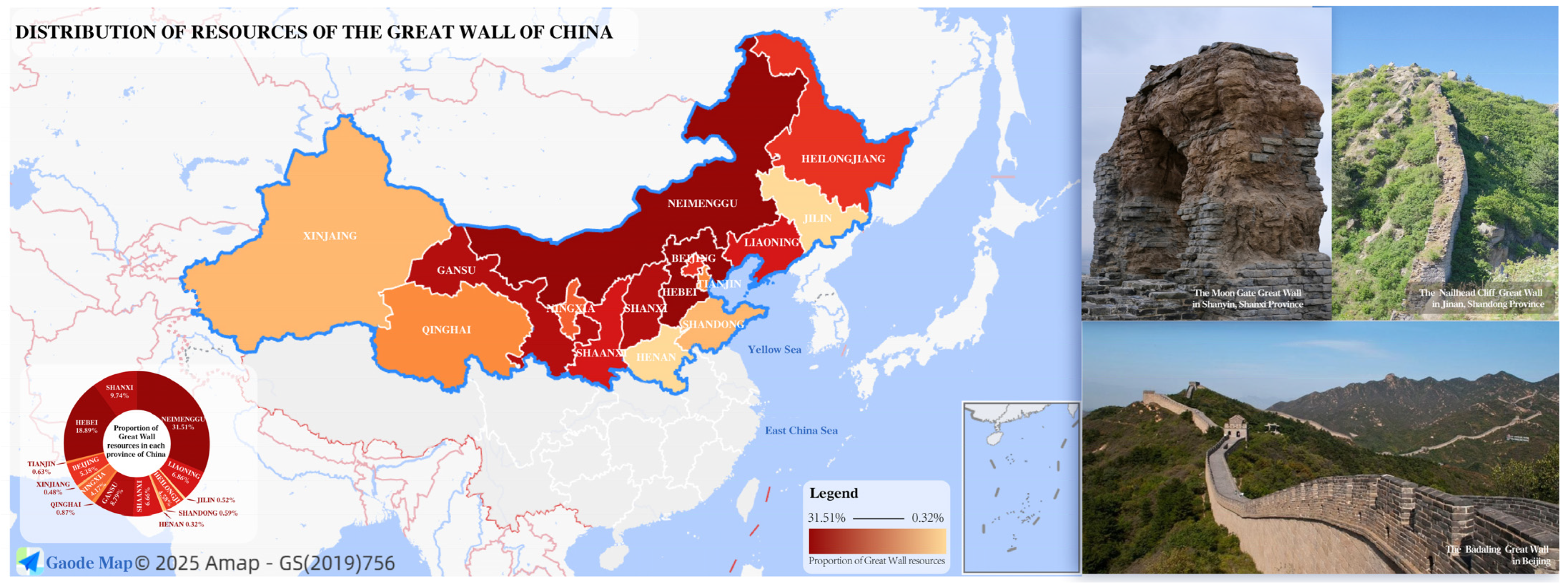

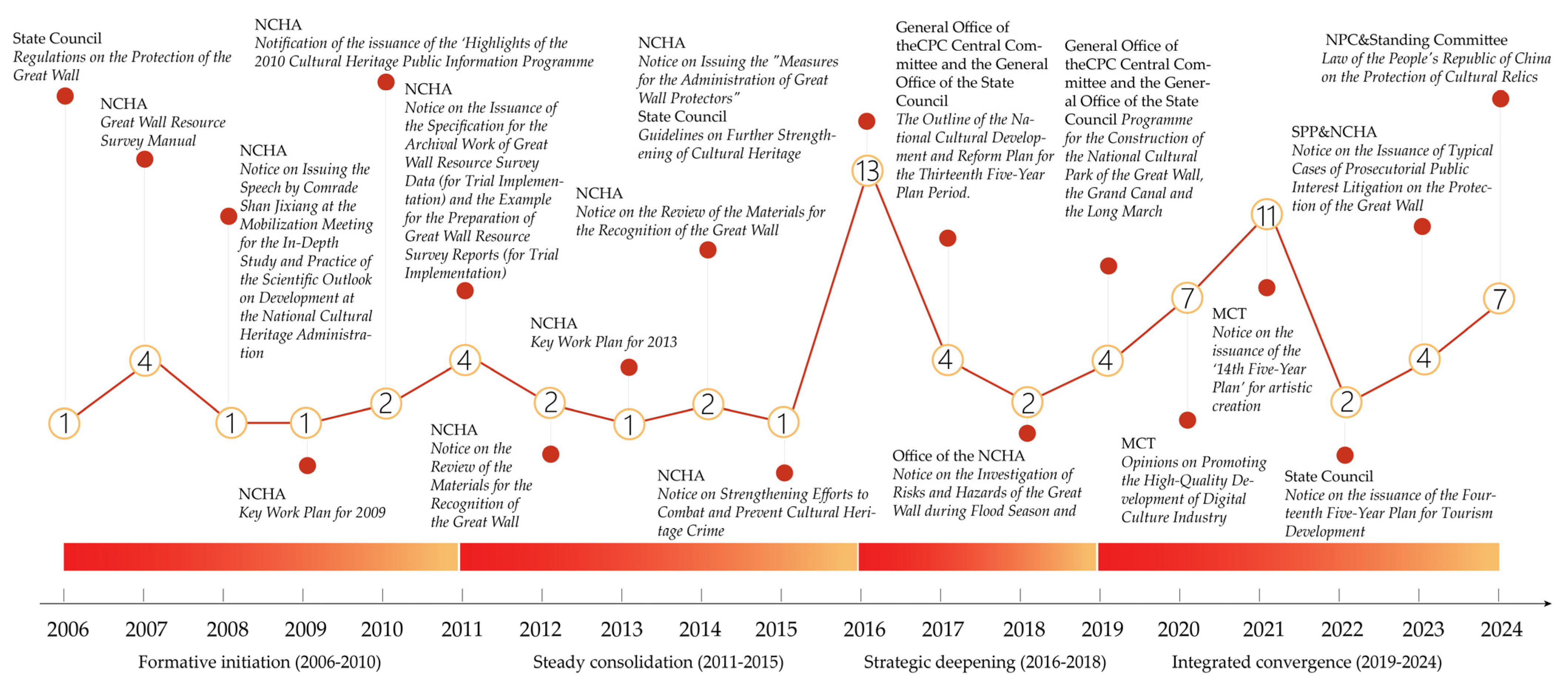
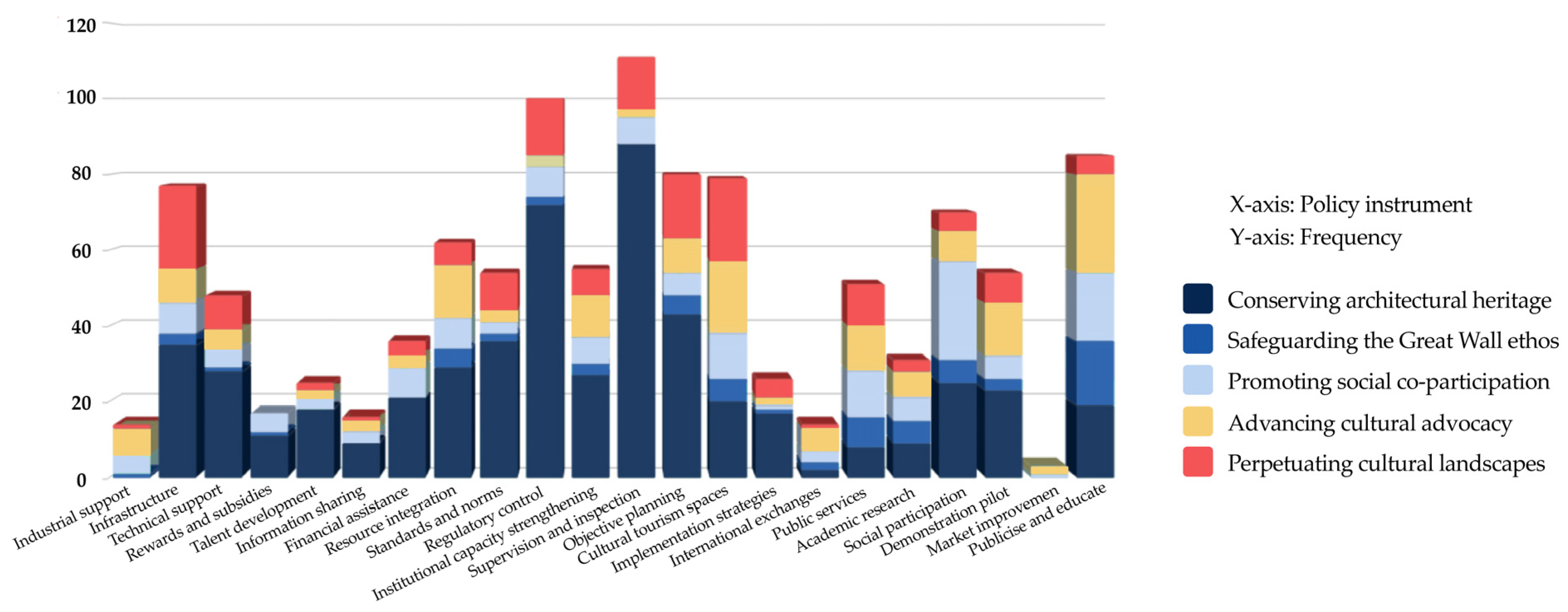
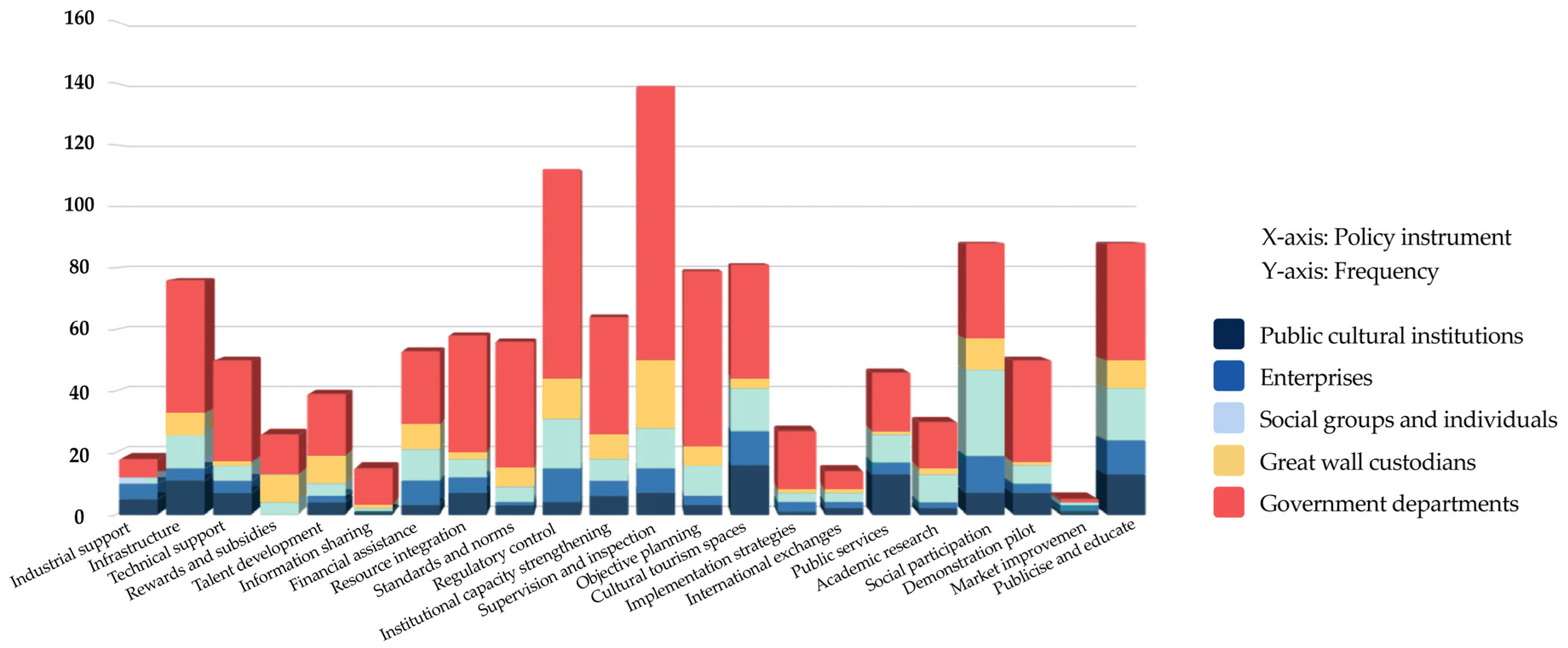
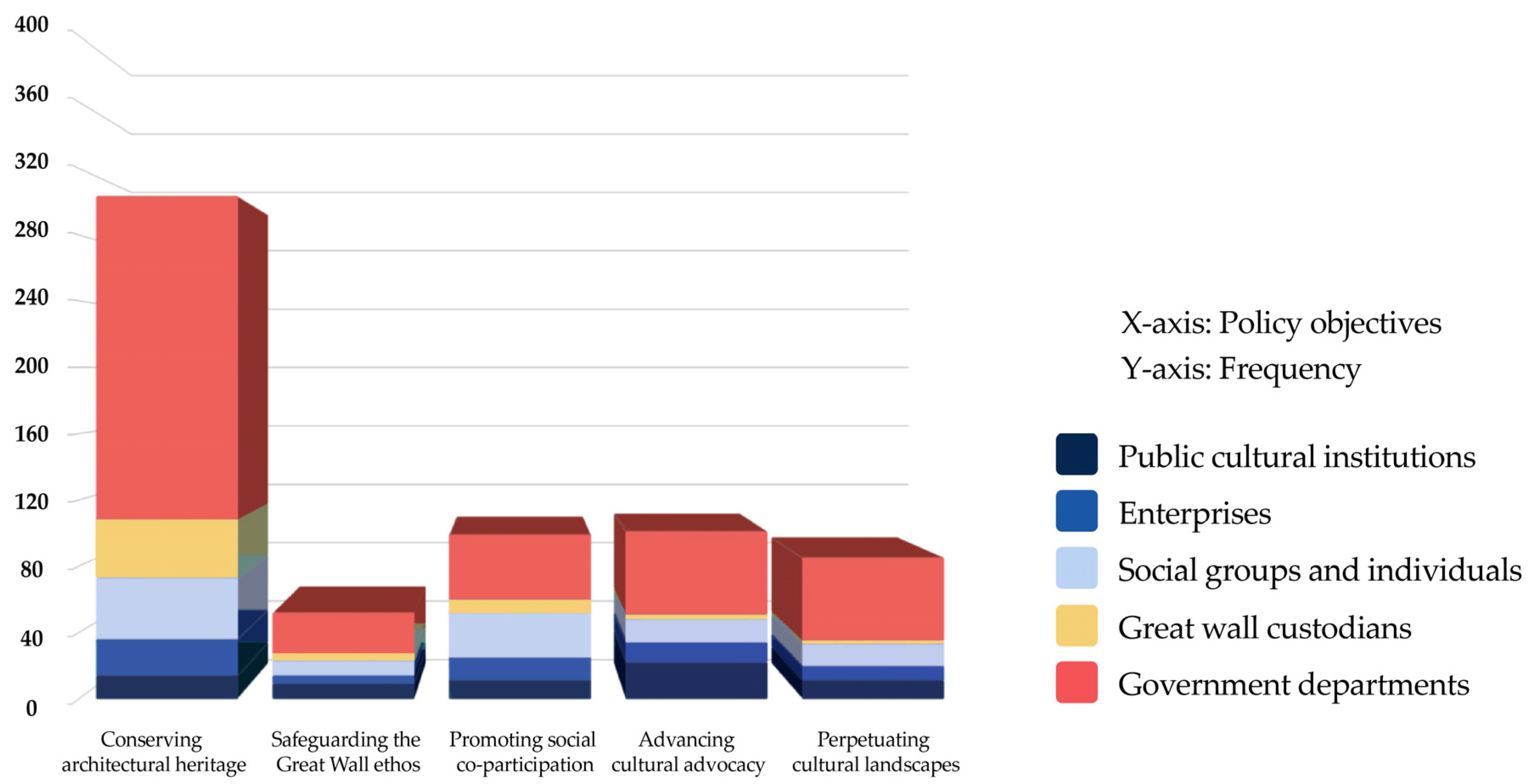
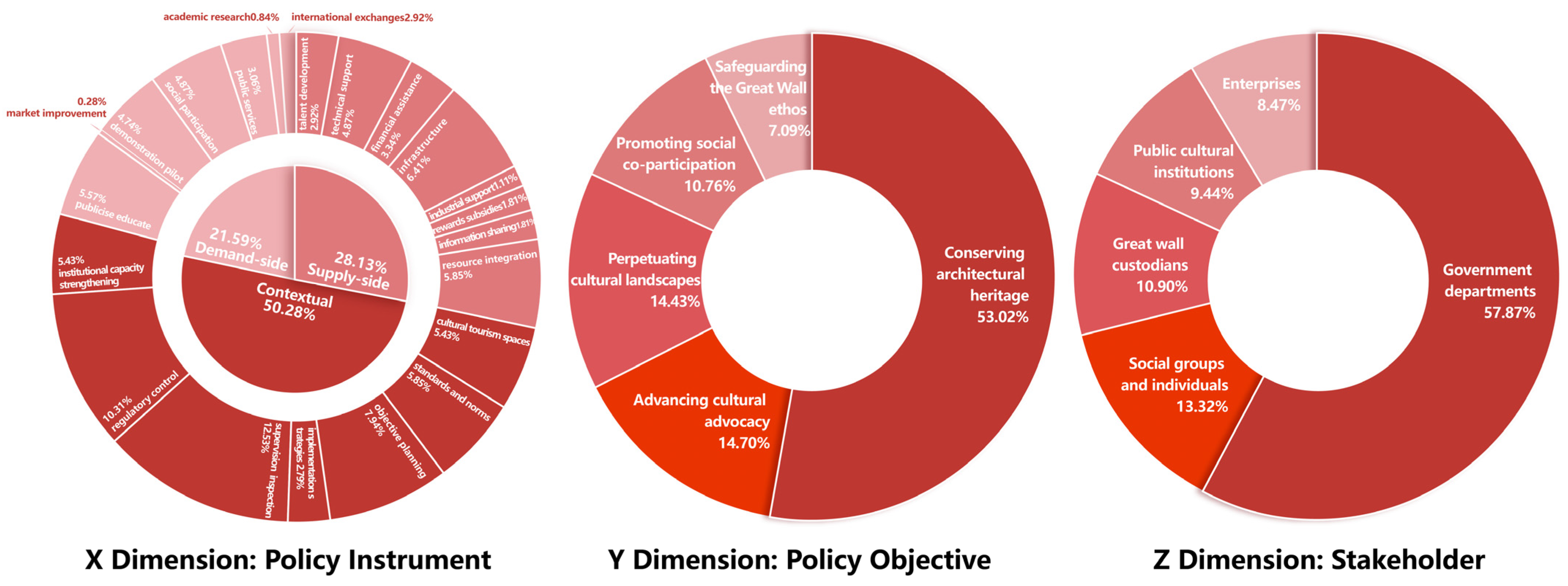
| Policy Title | Analysis Modules | Policy Instrument | Policy Objectives | Stakeholders |
|---|---|---|---|---|
| Guidelines for the “Four Must-Haves” in Great Wall Conservation Work | Encourage social forces to participate in Great Wall protection. County-level people’s governments along the Great Wall should establish and improve the Great Wall protection personnel system, specifying recruitment, responsibilities, performance evaluation, and subsidies. | Rewards and subsidies, institutional capacity strengthening, social participation | Conserving its architectural heritage, promoting social co-participation | Government departments, Great Wall custodians |
| The Great Wall Conservation Masterplan | The authorities managing Great Wall tourism areas must regularly update and publish tourist capacity limits based on monitoring data and assessment results, in compliance with Great Wall protection requirements. | Cultural tourism spaces, social participation | Conserving its architectural heritage, promoting social co-participation | Government departments, social groups, and individuals |
| Notice on the Publicity Activities of “5–18 International Museum Day” in 2022 | …and the construction of Chinese civilization markers, including Grand Canal, Long March, Great Wall, and Yellow River cultures...to advance inter-library exchanges, collaboration, and related explorations. | Resource integration, publicity, and education | Advancing its cultural advocacy | Government departments, public cultural institutions |
| Type of Policy Instrument | Policy Instrument Sub-Instrument | Frequency of Sub-Instrument | Percentage of Sub-Instrument | Frequency of Policy Instrument | Percentage of Policy Instrument |
|---|---|---|---|---|---|
| Supply-side | Talent development | 21 | 10.40% | 202 | 28.13% |
| Technical support | 35 | 17.33% | |||
| Financial assistance | 24 | 11.88% | |||
| Rewards and subsidies | 46 | 22.77% | |||
| Infrastructure | 8 | 3.96% | |||
| Industrial support | 13 | 6.44% | |||
| Information sharing | 13 | 6.44% | |||
| Resource integration | 42 | 20.79% | |||
| Contextual | Cultural tourism spaces | 39 | 10.80% | 361 | 50.28% |
| Standards and norms | 42 | 11.63% | |||
| Objective planning | 57 | 15.79% | |||
| Implementation strategies | 20 | 5.54% | |||
| Supervision and inspection | 90 | 24.93% | |||
| Regulatory control | 74 | 20.50% | |||
| Institutional capacity strengthening | 39 | 10.80% | |||
| Demand-side | Publicity and education | 40 | 25.81% | 155 | 21.59% |
| Market improvement | 2 | 1.29% | |||
| Demonstration pilot | 34 | 21.94% | |||
| Social participation | 35 | 22.58% | |||
| Public services | 22 | 14.19% | |||
| Academic research | 6 | 3.87% | |||
| International exchanges | 7 | 4.52% |
| Policy Objective | Frequency | Percentage |
|---|---|---|
| Conserving architectural heritage | 202 | 53.02% |
| Advancing cultural advocacy | 56 | 14.70% |
| Perpetuating cultural landscapes | 55 | 14.43% |
| Promoting social co-participation | 41 | 10.76% |
| Safeguarding the Great Wall ethos | 27 | 7.09% |
| Stakeholders | Frequency | Percentage |
|---|---|---|
| Government Departments: | 239 | 57.87% |
| Social Groups and Individuals | 55 | 13.32% |
| Great Wall Custodians | 45 | 10.90% |
| Public Cultural Institutions | 39 | 9.44% |
| Enterprises | 35 | 8.47% |
Disclaimer/Publisher’s Note: The statements, opinions and data contained in all publications are solely those of the individual author(s) and contributor(s) and not of MDPI and/or the editor(s). MDPI and/or the editor(s) disclaim responsibility for any injury to people or property resulting from any ideas, methods, instructions or products referred to in the content. |
© 2025 by the authors. Licensee MDPI, Basel, Switzerland. This article is an open access article distributed under the terms and conditions of the Creative Commons Attribution (CC BY) license (https://creativecommons.org/licenses/by/4.0/).
Share and Cite
Chen, Y.; Wang, Z.; Zhao, J.; Zhao, X.; Zuo, S.; Zhao, J.; Liu, W. Paths to Policy Sustainability for Protecting Cultural Heritage: A Quantitative Analysis of Conservation Policies for the Great Wall Within the “Instrument–Objective–Stakeholder” Framework. Sustainability 2025, 17, 4378. https://doi.org/10.3390/su17104378
Chen Y, Wang Z, Zhao J, Zhao X, Zuo S, Zhao J, Liu W. Paths to Policy Sustainability for Protecting Cultural Heritage: A Quantitative Analysis of Conservation Policies for the Great Wall Within the “Instrument–Objective–Stakeholder” Framework. Sustainability. 2025; 17(10):4378. https://doi.org/10.3390/su17104378
Chicago/Turabian StyleChen, Yu, Zeyi Wang, Jingwen Zhao, Xinyi Zhao, Sixue Zuo, Jingwen Zhao, and Weishang Liu. 2025. "Paths to Policy Sustainability for Protecting Cultural Heritage: A Quantitative Analysis of Conservation Policies for the Great Wall Within the “Instrument–Objective–Stakeholder” Framework" Sustainability 17, no. 10: 4378. https://doi.org/10.3390/su17104378
APA StyleChen, Y., Wang, Z., Zhao, J., Zhao, X., Zuo, S., Zhao, J., & Liu, W. (2025). Paths to Policy Sustainability for Protecting Cultural Heritage: A Quantitative Analysis of Conservation Policies for the Great Wall Within the “Instrument–Objective–Stakeholder” Framework. Sustainability, 17(10), 4378. https://doi.org/10.3390/su17104378





